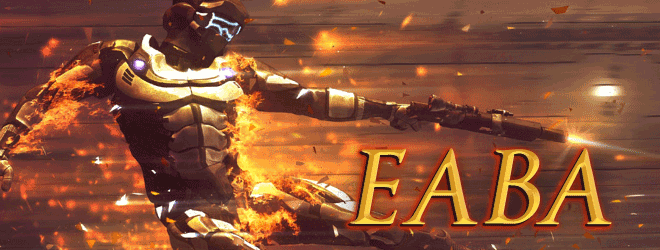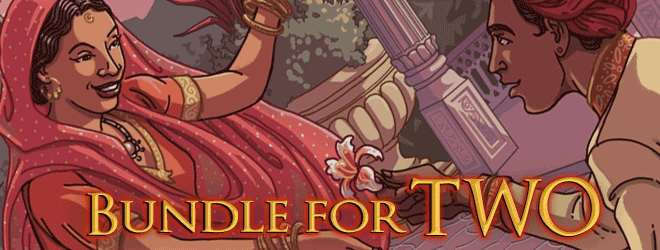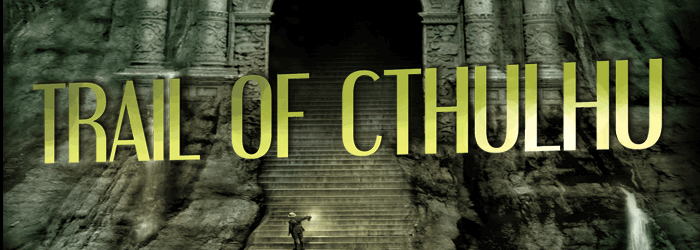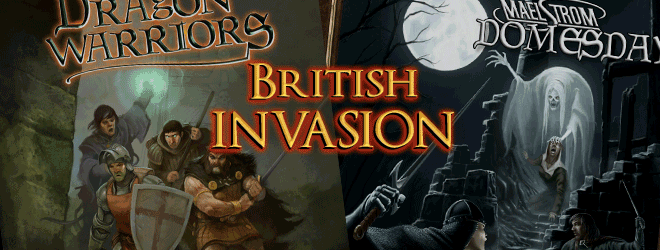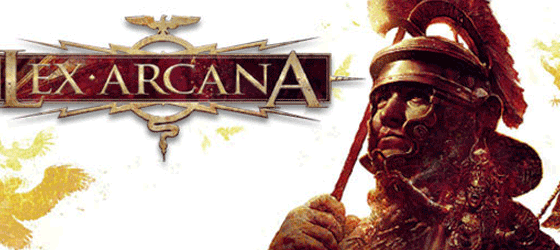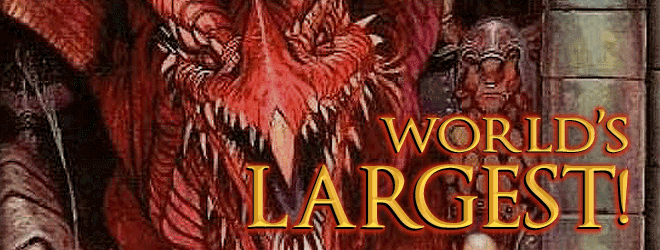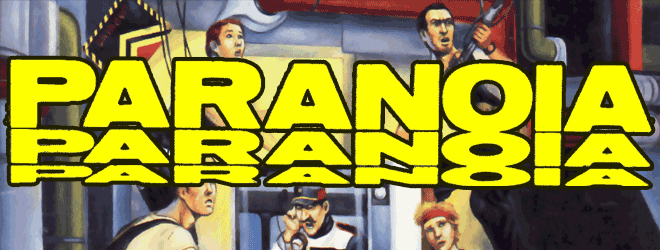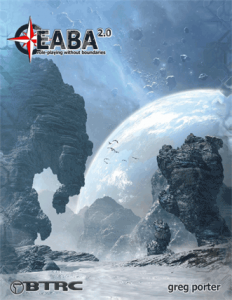 In April 2019 we presented the EABA Bundle featuring EABA, the versatile Simulationist universal system by Greg Porter (Corps, TimeLords). With EABA‘s scaling rules you can build anything from a zipgun to a battleship, and run any conflict from a schoolyard fight to a superhero slugfest. The state-of-the-art interactive .PDF campaign settings in this bargain-priced collection ranged from steampunk to space opera, all using the same coherent, deeply thought-out system.
In April 2019 we presented the EABA Bundle featuring EABA, the versatile Simulationist universal system by Greg Porter (Corps, TimeLords). With EABA‘s scaling rules you can build anything from a zipgun to a battleship, and run any conflict from a schoolyard fight to a superhero slugfest. The state-of-the-art interactive .PDF campaign settings in this bargain-priced collection ranged from steampunk to space opera, all using the same coherent, deeply thought-out system.
Across four decades Greg Porter has sought the grail of Simulation. In the Threefold Model and GNS theory of roleplaying design, Simulationist games seek accurate modeling and consistent fine-grained replication of their setting’s interactions; the campaign universe should operate sensibly independent of player concerns. In 1983 Porter, an old hand with rules-heavy simulations such as GURPS and Car Wars, founded his one-gamer company BTRC (“Blackburg [Virginia] Tactical Research Center”) to publish ambitious Simulationist RPGs. Now living an isolated life atop remote Fork Mountain south of Roanoke, Porter still pursues his 35-year quest in highly individual designs such as Corps and, most recently, EABA (“Ee-buh”). That stands for “End-All, Be-All,” a whimsically grandiose name for a thoroughly practical universal rules set.
EABA is a roll-over dice-pool system. Your attributes and skills determine the number of six-sided dice you roll; you total the three highest D6s, trying to beat a specified difficulty number. (The “Larger Than Life” advantage allows your best four rolls, best five, etc.) A Universal Scale relates dice to damage and recovery, mass and size, distance and area, time, money, quantity, and more. Using this one-page chart, you can easily determine most in-game relationships.
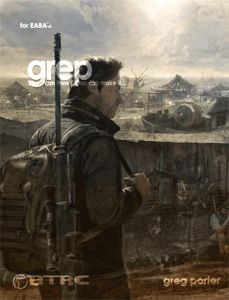 The chart also helps you set genre-appropriate baselines for your campaign world. Its default cost levels and “efficiency threshold” adjustments (for super-powers) help ensure characters have equipment and abilities suited to the setting’s genre and technology. Once you’ve set the ground rules, the Universal Scale lets you craft powers, effects, and modifiers. EABA scales smoothly across many power levels, giving a nice range of variation for normals without going overboard for guys who can pick up a tank.
The chart also helps you set genre-appropriate baselines for your campaign world. Its default cost levels and “efficiency threshold” adjustments (for super-powers) help ensure characters have equipment and abilities suited to the setting’s genre and technology. Once you’ve set the ground rules, the Universal Scale lets you craft powers, effects, and modifiers. EABA scales smoothly across many power levels, giving a nice range of variation for normals without going overboard for guys who can pick up a tank.
Combat uses an unusual initiative system where combatants bid secretly to see who acts first, and there’s an action penalty for rushing. In a round, after you take one major action and one minor action, each additional action incurs a cumulative dice penalty. How much time does a combat round represent? That’s EABA‘s most interesting innovation, a fusion of realism and drama.
“I started thinking about it when I tried to model cool scenes from movies as game turns,” Greg Porter explained in a Hardboiled GMshoe online chat in 2014. “You just cannot do it on a second-by-second basis.” The rulebook cites the lobby gunfight in The Matrix (1999): “From the first revealing of weapons to the final body falling is about 150 seconds. Even if the time onscreen was divided equally between the two protagonists, in a game with one-second rounds this would take 75 rounds to play, or about three days of your typical gamer wrangling, planning, and arguing. In EABA this entire scene would be seven or eight rounds long.”
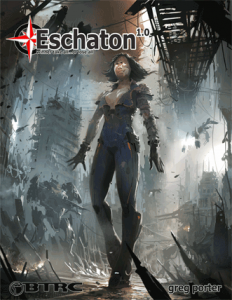 EABA rounds lengthen as the fight progresses, either as specified on the Universal Chart or to serve the Gamemaster’s dramatic needs. The expanding turn scale accentuates the immediate in the early stages of a fight, then the dramatic later on. The first round lasts one second; later rounds double in length, up to 16 minutes at Round 10. Regardless of round length, you still get one major and one minor action — but each later round grants an increasing “turn mod” bonus, representing your increased time for planning, focus, effort, or supplies spent. This means it’s important you draw your gun faster than your opponent, and that can take a single round — but running around the building, breaking into a car, hotwiring it, and driving it through the wall to surprise the bad guys can also take a single round. For players used to stopping the game for five minutes to plan their next one-second round, EABA‘s expanding combat turns inherently give their characters time to confer in-game.
EABA rounds lengthen as the fight progresses, either as specified on the Universal Chart or to serve the Gamemaster’s dramatic needs. The expanding turn scale accentuates the immediate in the early stages of a fight, then the dramatic later on. The first round lasts one second; later rounds double in length, up to 16 minutes at Round 10. Regardless of round length, you still get one major and one minor action — but each later round grants an increasing “turn mod” bonus, representing your increased time for planning, focus, effort, or supplies spent. This means it’s important you draw your gun faster than your opponent, and that can take a single round — but running around the building, breaking into a car, hotwiring it, and driving it through the wall to surprise the bad guys can also take a single round. For players used to stopping the game for five minutes to plan their next one-second round, EABA‘s expanding combat turns inherently give their characters time to confer in-game.
EABA‘s combat system provides plenty of crunch, with rules for cover, opportunity and covering fire, weapon arcs, advanced aiming, special ammo types, explosions (fragmentation and blast), lethal and nonlethal damage, crippling and bleeding, technology level, and much more. The Stuff! equipment supplement adds extensive rules for weapons, vehicles, gadgets, and creatures. If you think it’s important in combat, rest assured: It’s here.
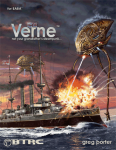 There were four titles in this offer’s Starter Collection (retail value $57), including the complete EABA v2.01 core rulebook, the steampunk-Martian-dinosaur extravaganza Verne (and the beautiful Verne Maps set); and the post-scarcity nanotech setting grep.
There were four titles in this offer’s Starter Collection (retail value $57), including the complete EABA v2.01 core rulebook, the steampunk-Martian-dinosaur extravaganza Verne (and the beautiful Verne Maps set); and the post-scarcity nanotech setting grep.
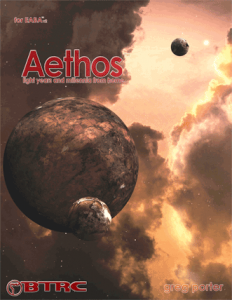 Those who paid more than the threshold (average) price also got our entire Bonus Collection with five more supplements and campaign sourcebooks worth an additional $78:
Those who paid more than the threshold (average) price also got our entire Bonus Collection with five more supplements and campaign sourcebooks worth an additional $78:
- Stuff!: A comprehensive equipment construction set that lets you build anything from a penknife to an orbital bombardment platform.
- Aethos: Hard-sf space opera, espionage, and political aboard a colossal alien worldship.
- Agency: Modern magickal intrigue in a campaign where only you are Real, and everyone else is just Scenery. Includes the 1957 companion game that puts you at the heart of the setting’s early history.
- Eschaton: Realistic superheroics in the wake of a sudden event that bestows super-powers on hundreds of thousands of people worldwide.
Many of these EABA titles are advanced .PDFs with interactive features that enhance tabletop play. For instance, the EABA core rulebook .PDF in this offer has a built-in dice roller; its character sheets do calculations automatically; you can generate characters and vehicles with one click; and you can draw and erase on the maps. .PDF readers that support the advanced features include Adobe Reader (desktop), Readdle’s PDF Expert (iOS), and and Foxit MobilePDF or Qoppa Software’s qPDF Notes (Android).
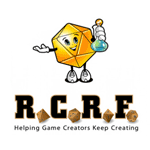 Ten percent of each payment (after gateway fees) went to the charity designated by EABA designer Greg Porter, the RPG Creators Relief Fund. The RCRF is a 501(c)(3) nonprofit charitable organization founded to provide financial assistance to tabletop roleplaying game creators suffering hardship due to medical emergencies, natural disasters, and other catastrophic situations.
Ten percent of each payment (after gateway fees) went to the charity designated by EABA designer Greg Porter, the RPG Creators Relief Fund. The RCRF is a 501(c)(3) nonprofit charitable organization founded to provide financial assistance to tabletop roleplaying game creators suffering hardship due to medical emergencies, natural disasters, and other catastrophic situations.
